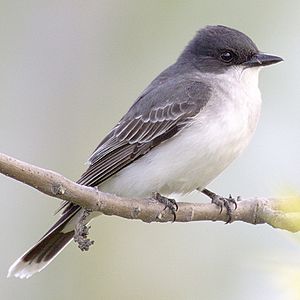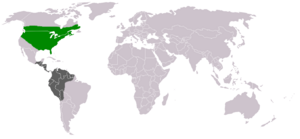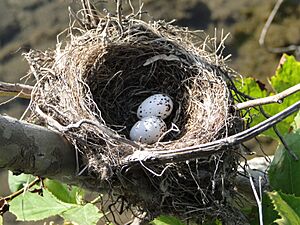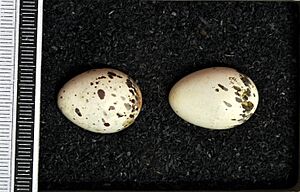Eastern kingbird facts for kids
Quick facts for kids Eastern kingbird |
|
|---|---|
 |
|
| Adult | |
| Conservation status | |
| Scientific classification | |
| Genus: |
Tyrannus
|
| Species: |
tyrannus
|
 |
|
| T. tyrannus range Breeding range Wintering range | |
| Synonyms | |
|
Lanius tyrannus Linnaeus, 1758 |
|
The eastern kingbird (its scientific name is Tyrannus tyrannus) is a cool bird. It's a type of tyrant flycatcher. These birds live in North and South America. They are mostly dark gray with a white belly. Their wings are pointed.
You can often spot them in open places. Look for them in fields with a few trees or bushes. They like to perch there while hunting for insects. Eastern kingbirds travel long distances. They breed in North America. Then they fly south to Central and South America for winter.
Contents
About the Eastern Kingbird
How Scientists Name Birds
A Swedish scientist named Carl Linnaeus first described this bird in 1758. He gave it the name Lanius tyrannus. Later, in 1799, another scientist gave it the name Tyrannus. This is the first part of its scientific name today. The eastern kingbird is the main example for the Tyrannus group. This bird is a single species, meaning there are no different types (subspecies) of it.
What Eastern Kingbirds Look Like
Adult eastern kingbirds have grey-black feathers on their top half. Their belly is light-colored. They have a long black tail with a white tip. Their wings are long and pointed. They also have a small red patch on their head. You don't often see this red patch.
They are a medium-sized kingbird. They are about 19 to 23 centimeters (7.5 to 9 inches) long. Their wingspan is about 33 to 38 centimeters (13 to 15 inches). They weigh between 33 and 55 grams (1.2 to 1.9 ounces).
Their call sounds like a high-pitched buzz. Some people say it sounds like an electric fence.
Where Eastern Kingbirds Live and Travel
Eastern kingbirds build their nests in open areas across North America. They make a strong cup-shaped nest in a tree or bush. Sometimes they build it on top of a stump or pole. These birds are very brave. They will strongly protect their nesting area. They even chase away much bigger birds!
These birds travel in large groups to South America for the winter. Very rarely, some eastern kingbirds have been seen in Europe. There have been three sightings in the British Isles. Two were in Ireland and one in Scotland.
Eastern Kingbird Behavior
Nesting and Raising Young
Some eastern kingbirds build their nests in the open. Others hide their nests very well. In British Columbia, eastern kingbirds might nest in open fields. They also nest in bushes over water, high in trees, or even on top of small stumps.
Both the male and female kingbirds help protect their nest. Females with well-hidden nests might stay on the nest longer. Females with open nests might leave earlier to chase away animals that could harm their young. Pairs nesting in the open can see danger coming sooner. They use their aggressive behavior to keep their babies safe.
Kingbirds are known for "mobbing" other birds. This means they fly together to chase away bigger birds. This behavior helps keep ravens and crows away from their nests. Birds like Blue jays, American crows, squirrels, and tree-climbing snakes sometimes eat kingbird eggs or babies. American kestrels might hunt adult kingbirds.
What Eastern Kingbirds Eat
Eastern kingbirds like to sit on an open branch. From there, they fly out to catch insects in the air. Sometimes they hover in the air to pick bugs off plants. They also eat berries and fruit. They mostly eat fruit when they are in their winter homes.
Images for kids








